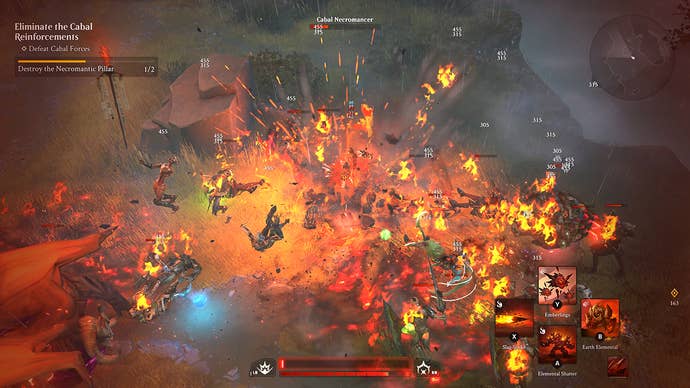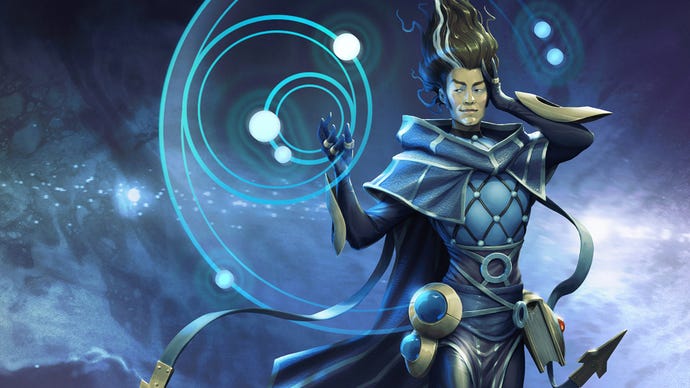Magic: Legends Has a Solution to a Problem That Has Plagued Diablo and Path of Exile
Down with the click-click-click of the action-RPG!
This article first appeared on USgamer, a partner publication of VG247. Some content, such as this article, has been migrated to VG247 for posterity after USgamer's closure - but it has not been edited or further vetted by the VG247 team.
I'm not a huge fan of the classic action-RPG control scheme popularized by Diablo. Click to move, click to attack; it's just a lot more clicking than I prefer to do. Over the years, there's been a glimmer of hope with Diablo 3: Ultimate Evil Edition and Torchlight 2 on console adopting a control scheme that's a bit closer to twin-stick shooter, with one stick to move and the other to aim. I've tried to play modern ARPGs like Path of Exile and Wolcen: Lords of Mayhem, only to find no alternate control schemes.
"When you're playing on the PC, you're not really looking at your character as much, you're kind of focusing on the cursor. Whereas on console it's the exact opposite, you're drawn in," Diablo 3: Ultimate Evil Edition senior level designer Matthew Berger told Eurogamer when that title came to consoles. Blizzard declined to allow controller support on the PC version of Diablo 3, saying it was a balance issue. "The games have really been structured to take advantage of their environment and their ecosystem, so in the same way it would not be a good fit to put a mouse and keyboard on the console. It wouldn't work," Berger added.
So picking up a controller on a demo of Cryptic Studios's Magic: Legends at PAX East 2020, I'm struck that it's already built for a controller. Magic: Legends executive producer Stephen Ricossa seems surprised that I'm so excited about the console-focused control scheme. In fact, he shows me that the game can switch between control options on the fly. He presses a key on the keyboard, and the user interface switches to something built for PC, something classic Diablo players might prefer. "It's totally seamless, you don't have to change a setting," says Ricossa. It's indicative of the level of thought that Cryptic is putting into Magic: Legends and makes me automatically click with the game over some of its competition.
Magic: Legends is a spinoff of the classic Magic: The Gathering card game, trying to bring that experience to a digital action game. There will eventually be five character classes that match up with the Mana colors Magic players built their decks around: Red, Blue, Green, Black, and White. Red is the Geomancer, direct damage dealer that uses Earth to smash enemies at close range. Blue has the Mind Mage, who instead prefers to fight at range, confusing and controlling his enemies. And at PAX East, Cryptic also showed off the Green-focused Beastcaller, who has a persistent pet and fights by buffing large numbers of summoned monsters.
The "Magic" of the game is rooted in the combat system. All of your attacks are bound to face buttons on your controller, or 1-4 on PC. When you use a spell, it's consumed completely, and then another spell is chosen at random from your unseen deck. Like Magic: The Gathering, proper play in Magic: Legends is focused on building a deck that will synergize with your class. This card-based combat system has been a part of Magic: Legends since the design phase, according to Ricossa.
"This system was designed when the game was just a paper idea, before a single pixel had been pushed. The biggest issue was not coming up with this idea, it was coming up with the mana system that was able to feed it well. Classes and everything have grown so much over the years of development," he says.
Each class begins with a starter deck of sorts, which you can build upon. "We give you a starter deck with the class, but the deck is fully customizable. This is similar to a deck-building game. It can be multi-mana as well, so you can Geomancer with an all-green deck, or maybe there is like a Red-White deck that you like," Ricossa says. "Not every single spell here is inspired exactly by a card. The ones that are in the starter decks, we try to make a Geomancer playing experience that we know is fun. If you don't change your deck, you just level it up, you're fine. If you customize it then you're making choices to make things easier or harder on yourself."
Every class has a standard attack, a signature magic spell, and a movement ability. The Beast Caller for example, swings a massive axe as her standard attack and has a straight dash charge as her movement ability. Her signature spell, has her tossing the axe like a boomerang, with all damage done healing her persistent Ether Fox pet. Clases are about playstyle, not locking you into a specific Mana type, though they do work in tandem with certain colors.
"The Geomancer, when she casts a damage spell, she does 40% more damage than the Mind Mage casting the exact same spell. The Beastcaller is all about summoning creatures; her creatures have 15% more health and more damage across the board. You're setting your deck, and then picking the optimal class to really set off that deck," says Ricossa.
While I'm the Geomancer, I'm taunting enemies into range with an Earth Elemental, and blasting them apart with shotgun blasts and whirlpool's of fire. As the Mind Mage, I instead stayed away from the battle, summoning creatures as a bulwark, putting some enemies to sleep, and charming key foes to fight for me. Again, this is with the starter decks included; if you want to build a more direct damage deck for your Mind Mage, you can.
Given Cryptic Studios' past, I'm a bit surprised to see Magic: Legends using the overhead Diablo-style camera. It's not isometric, given that you can rotate the camera freely, but the viewpoint is an odd choice given Cryptic previous games, like Neverwinter and Star Trek: Online.
"We started with a traditional third-person camera. We found that, for larger creatures, you couldn't see around them. In this battlefield where you have friendlies squaring off against enemies, we want you to be able to make a decision like, 'I'm going to drop a spell there, I'm going to throw up an assist there.' With this camera, you can make those choices. Also, for a combat-heavy game, it just helps you see the battlefield," says Ricossa. He explains that they played with the third-person camera for six months before settling on the action-RPG camera.
Ricossa only briefly shows me the deck-building interface of Magic: Legends. The cards that represent useable spells and summon drop as loot, instead of the normal Diablo-style equipment. You use this stock to build decks and upgrade specific cards. Ricossa says there's a separate progression system that Cryptic isn't talking about yet. Creatures have a specific cost and any deck has a maximum creature cost. So while a smaller summon may cost a single point, something like the massive Enormous Baloth costs 4 points. Ricossa says that nearly every creature—except bosses—you fight can be summoned by the player.

"If they're named, they're probably a boss," he tells me. "Everything you're fighting, you can also summon. Literally everything you see that you're fighting is also a card in our game."
Behind the combat system, the classes, and cards, Magic: Legends is still technically an MMO. Ricossa says there will be guilds, player spaces to hang out in, extensive visual customization for players, and various multiplayer modes. PvP is currently 1v1 based, similar to Magic: The Gathering duels. "It's funny, the 1v1 duel system was originally just a place to like test new spells and it was so fun that, 'You know, I think we're going to ship it.'" he jokes.
PvE multiplayer is currently built for 1-3 players, as opposed to a more standard size of 4-5 players. Ricossa says that was a balance choice, not a technical one. "If you look at our other games, we can do five-player teams, we can do 20-player teams. But because Magic has five colors and each color is a specific weakness, if we allowed five-player teams, you could cover every weakness. With three, you're making a choice. It makes for a most interesting design space," he says.
Magic: Legends still has a long way to go before release on PC, Xbox One, and PlayStation 4. There's a planned beta and currently, only three of the game's five planned classes have been announced. Cryptic is prepared for the future of Magic: Legends though, and more is planned. "Absolutely more classes. New places to fight, new creatures," says Ricossa.



